Australia’s top earning female athletes: Sam Kerr, Stephanie Gilmore, Ellyse Perry and Ash Gardner
While some sports now offer a solid financial reward, AFL execs say they can’t justify big AFLW contracts, with ratings down 70pc and crowds falling 60pc.
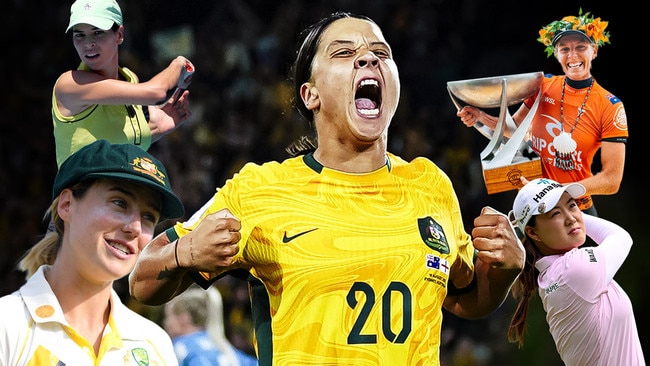
“We need funding in our grassroots. We need funding everywhere. The comparison to other sports isn’t really good enough.”
They were the words spoken by Matildas skipper Sam Kerr in the aftermath of the epic semi-final against England on Wednesday. It hit home as powerfully as the star striker’s incredible goal.
Kerr and the Matildas have captured the hearts of a nation during the Women’s World Cup, so much so their loss to England was the most watched TV program in two decades.
But after the Matildas play Sweden on Saturday evening in Brisbane for third place, federal government funding – about $10m over two years that has helped them prepare for the tournament – runs out.
After the glory, comes uncertainty. The narrative about the Matildas and women’s sport has been that this tournament will be a game changer. And there are high hopes that it will be.
But next, the Matildas will try to qualify for the 2024 Paris Olympics with less high-performance funding ($1.9m) from the federal government than what rugby union receives ($2.5m).
That $1.9m is for both the men’s and women’s programs. Meanwhile, other sports such as equestrian, netball, swimming, shooting and sailing get more than soccer in high-performance funding.
Federal government reluctant to step up
James Johnson, the chief executive of Football Australia, won’t be drawn on the funding, other than to say: “We appreciate the federal government’s funding of the high performance pillar within our Legacy ‘23 strategic plan. It made a big difference to their preparation for the Women’s World Cup.”
As well as the elite level, Football Australia and various state bodies are on the cusp of a player boom, but desperately need money for grassroots and community infrastructure. Simple things such as female change rooms and toilets.
The FA has undertaken an audit of almost 2000 community and grassroots sporting facilities across the country, finding 507 out of 1947 facilities had no change rooms and only 42 per cent are female friendly.
But despite Prime Minister Anthony Albanese being a visible supporter at Matildas games – including high-fiving Kerr after one victory – alongside sports minister Anika Wells, the federal government has been reluctant to step up on the funding front.
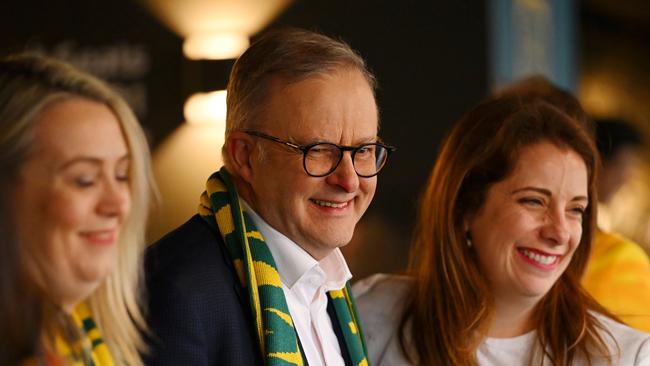
The same government that has pledged $240m for an AFL stadium in Hobart which is costing $715m and for which the richest sport in the country, the AFL, is putting up only $15m.
Meanwhile, Opposition leader Peter Dutton sought to exploit the issue this week by saying the Coalition would spend $250m on a Community Facilities Fund, with the states matching the figure.
Football Australia is also bidding for the 2026 Women’s Asian Cup, for which government support will be needed.
It is also up against a financial powerhouse in Saudi Arabia for the tournament, with a decision made by mid-next year.
“The most common comment that I get from football officials, media or colleagues around the world is ‘how did you commercialise women’s football’.”
Johnson says the success of the World Cup, on and off the field, shows that Football Australia’s gamble three years ago to elevate the Matildas brand to at least equal that of the Socceroos (it has now probably surpassed it) has paid off.
“The most common comment that I get from football officials, media or colleagues around the world is ‘how did you commercialise women’s football’. We are at the forefront of that change, and over the past three years as the numbers have grown, in match day and broadcast terms, the more revenue has come in.
“It has highlighted the importance to the sport of really tapping into global football and not trying to compete locally (with other sports). It is not our competitive strength.
“When we can engage and hardwire ourselves into global football that’s what brings the best out in the sport. That’s what we have seen in the past four weeks.”
For the young girls across the nation right now, with big athletic dreams, it’s becoming clearer which sports are looking after their athletes financially and which are lagging.
The average wage for a female cricketer will be $150,000 next season. It’s the highest among female sport in Australia.
Australia’s greatest earning sportswomen include Matildas and Chelsea star Kerr, world champion surfer Stephanie Gilmore and cricketers Ellyse Perry and Ash Gardner.
Being a millionaire sportswoman is not a fairytale, but only a possibility if playing cricket, soccer, tennis, surfing or golf.
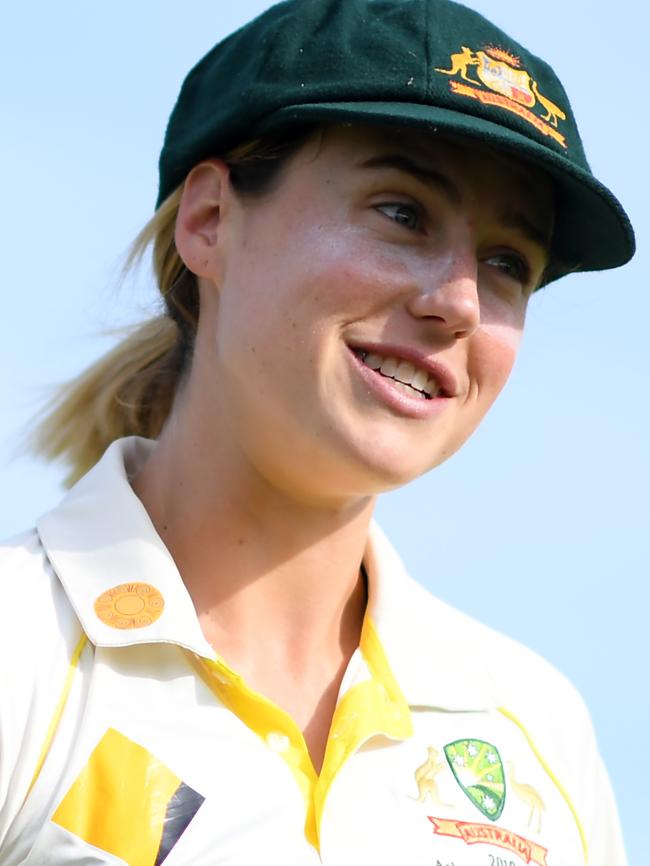
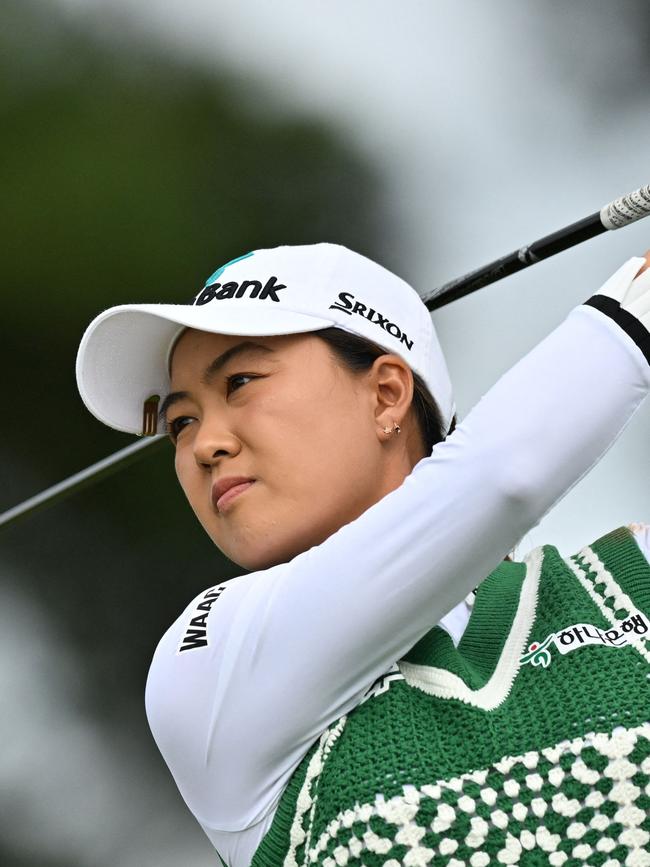
While the burgeoning leagues of AFLW and NRLW have gathered a lot of headlines over the years the sporting landscape has been shifted by the Matildas.
AFLW has done a brilliant job of mining the female talent pool, but there’s no doubt the Matildas’ success is going to have an impact.
As sports like cricket and soccer offer solid financial reward, some say the AFLW is in troubled waters.
AFL executives have already briefed clubs saying that they can’t justify the money they are paying to their female athletes with the poor ratings and dwindling crowds burdening the competition.
The AFLW ratings are down 70 per cent on season one and crowds are down 60 per cent.
The Disney documentary on AFLW, Fearless, has disappeared from the streaming platform. Sources say the interest was not there. On the other hand, the Matildas’ documentary The World At Our Feet is featuring front and centre.
AFLW ’grew too quickly’
Collingwood chief executive Craig Kelly several weeks ago didn’t mince his words on the struggling AFLW.
“We can’t just squeeze the lemon and start handing out the cash that we haven’t got as a whole competition so I’m saying to all our girls, ‘let’s keep investing let’s keep going forward,” Kelly told the ABC.
“There’s only a certain amount of money that goes around. Every time we put on another weekend of footy it costs a lot of money.”
Prue Gilbert, a gender equity expert and a lawyer who formerly served as an advisory board member for the AFL Players Association for the Women’s League, said more investment and less sexism would help AFLW.
“It’s disappointing to see attitudes towards AFLW still riddled with sexism,” Gilbert told The Weekend Australian. “Any gender disparity in performance, attendance or viewers is solely attributable to the AFL’s disproportionate – some would say discriminatory – investment model.
“It’s time for government intervention, as the battle of the sexes’ approach to equality hurts everyone. If we’re serious about ending gendered violence, fostering respect at work and realising equality, we need governments to mandate gender equitable investment in sport.”
There is a school of thought that the expansion of the AFLW was done at an unstainable rate. It is now 18-team competition but the fans have not come along for the ride. Broadcast expert Colin Smith, noting the drastic fall in ratings, agrees.
“They’ve been trying to grow it too quickly,” Smith said. “There is a sense the standard has dropped and so therefore the competitive intensity has dropped and the fan base has spoken.”
“Their TV ratings dropping 70 per cent is huge. That is a real concern and if I was the AFL, I would not be sticking to my position and showing no more than ten games probably for the next three to five seasons to build the standard over time. But by going with a mass product, with the same number of rounds, that will actually make it worse.”
There are also concerns around the safety of the game. Most recently former Adelaide Crow Heather Anderson, who took her own life, was found to have chronic traumatic encephalopathy. She was the second AFLW player found to have a brain injury post-mortem. Sydney private school Queenwood recently dumped Australian Rules from its sports program because of head injury concerns.
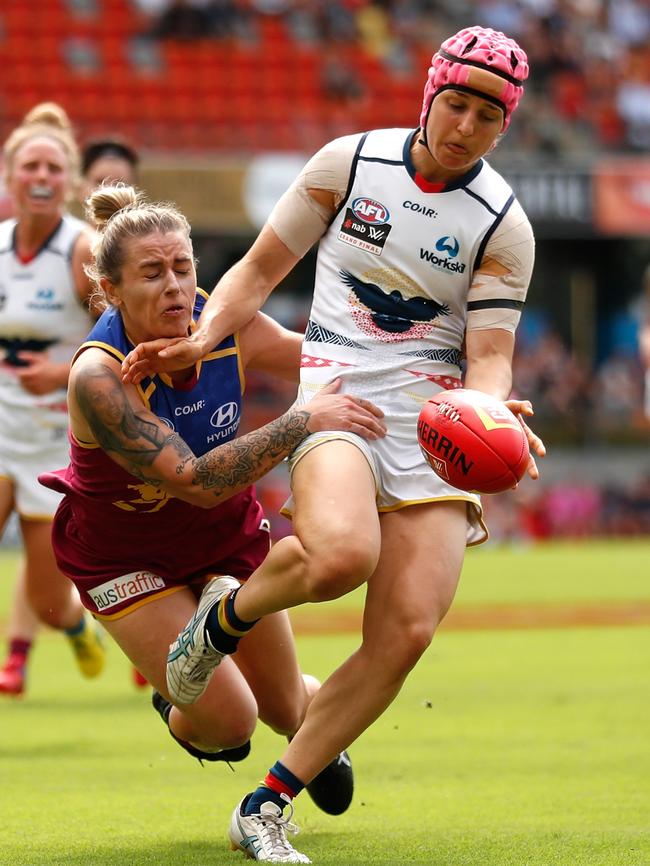
The impact of repetitive head impacts that football serves up to women specifically – in leagues like AFLW and NRLW – is yet to be studied extensively. It’s understood Football Australia is currently considering a ban on heading the ball for under 12s. Neurologists and neuroscientists are pushing for a reduction in heading in training, where most of the repetition occurs.
Safety aside, Smith said that the NRL had done a better job of managing their women’s league.
“They’ve taken a slowly, slowly approach and it’s at a fantastic standard,” Smith said.
It’s irrefutable that women are paid poorly in the Women’s A-League in comparison to other sports but it’s playing overseas for clubs like Kerr’s Chelsea where women can be rewarded healthily for the game.
Cricket Australia chief executive Nick Hockley is heartened by the opportunities being offered to women, noting the record crowd of 85,000 for the women’s cricket World Cup final in 2020.
“We are enormously proud of our pioneering investment in women’s cricket including the significant growth in wages and contract numbers and our support for international teams and the Weber WBBL,” Hockley told The Weekend Australian.
“Filling the MCG for the 2020 ICC Women’s T20 World Cup final was one of the great moments in Australian Cricket and it’s been amazing seeing the Matildas take support for women’s sport in Australia to the next level.
“It’s a really exciting time for sport in Australia and it’s wonderful to see the opportunities now available to women and girls at all levels.”
THE MILLIONAIRE’S CLUB
1. Minjee Lee (golf) $3.3m
2. Sam Kerr (soccer) $3m
3. Steph Gilmore (surfing) $2.5m
Ellyse Perry (cricket) $2.5m
4. Ajla Tomljanovic (tennis) $1.5m
Alyssa Healy (cricket) $1.5m
5. Grace Kim (golf) $1.23m
6. Ellie Carpenter (soccer) $1.2m
Mary Fowler (soccer) $1.2m
7. Storm Hunter (tennis) $1.17m
8. Hannah Green (golf) $1.08m
9. Ash Gardner (cricket) $1m
*Figures are based on earning potential in a year including endorsements
WAGES FOR AUSSIE SPORTSWOMEN
Cricket: Average: $150,00 minimum: $90,000
(Combined state domestic and WBBL contract from 2023/24. This is separate to CA central contracts for internationals)
Super Netball: Average: $75,00, minimum: $43,000
AFLW: Average: $47,000, minimum: $39,000
NRLW: Average: $38,000, minimum: $30,000
WNBL: Average: $38,000, minimum: $15,000
A League women: Average: $20,000 (last season),minimum $25,000*
*Minimum wage this season
